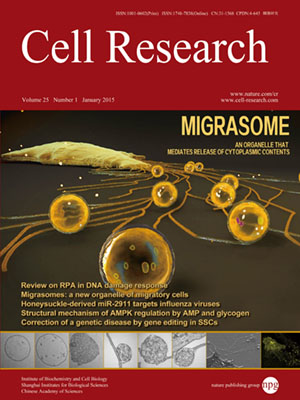Volume 25 Issue 1, January 2015: 67-79
ORIGINAL ARTICLES
Correction of a genetic disease by CRISPR-Cas9-mediated gene editing in mouse spermatogonial stem cells
Yuxuan Wu1,2,*, Hai Zhou1,2,3,*, Xiaoying Fan4,*, Ying Zhang2,5,*, Man Zhang1,2,*, Yinghua Wang1,2, Zhenfei Xie1,2, Meizhu Bai1,2,6, Qi Yin1,2, Dan Liang1,2, Wei Tang7, Jiaoyang Liao1,2, Chikai Zhou1,2, Wujuan Liu1,2, Ping Zhu4, Hongshan Guo4, Hong Pan1,2, Chunlian Wu3, Huijuan Shi8, Ligang Wu2,5, Fuchou Tang4 and Jinsong Li1,2,6
1Group of Epigenetic Reprogramming, State Key Laboratory of Cell Biology, Institute of Biochemistry and Cell Biology, Shanghai Institutes for Biological Sciences, Chinese Academy of Sciences, Shanghai 200031, China
2Shanghai Key Laboratory of Molecular Andrology, Institute of Biochemistry and Cell Biology, Shanghai Institutes for Biological Sciences, Chinese Academy of Sciences, Shanghai 200031, China
3College of Life Science, China West Normal University, Nanchong, Sichuan 637002, China
4Biodynamic Optical Imaging Center, Ministry of Education Key Laboratory of Cell Proliferation and Differentiation, College of Life Sciences, Peking University, Beijing 100871, China
5State Key Laboratory of Molecular Biology, Shanghai Key Laboratory of Molecular Andrology, Institute of Biochemistry and Cell Biology, Shanghai Institutes for Biological Sciences, Chinese Academy of Sciences, Shanghai 200031, China
6School of Life Science and Technology, Shanghai Tech University, Shanghai 200031, China
7Animal Core Facility, Institute of Biochemistry and Cell Biology, Shanghai Institutes for Biological Sciences, Chinese Academy of Sciences, Shanghai 200031, China
8National Population and Family Planning Committee, Key Laboratory of Contraceptive Drugs and Devices, Shanghai Institute of Planned Parenthood Research, Shanghai 200032, China
Correspondence: Jinsong Li, E-mail: jsli@sibcb.ac.cn; Fuchou Tang, E-mail: tangfuchou@pku.edu.cn; Ligang Wu,(lgwu@sibcb.ac.cn)
Spermatogonial stem cells (SSCs) can produce numerous male gametes after transplantation into recipient testes, presenting a valuable approach for gene therapy and continuous production of gene-modified animals. However, successful genetic manipulation of SSCs has been limited, partially due to complexity and low efficiency of currently available genetic editing techniques. Here, we show that efficient genetic modifications can be introduced into SSCs using the CRISPR-Cas9 system. We used the CRISPR-Cas9 system to mutate an EGFP transgene or the endogenous Crygc gene in SCCs. The mutated SSCs underwent spermatogenesis after transplantation into the seminiferous tubules of infertile mouse testes. Round spermatids were generated and, after injection into mature oocytes, supported the production of heterozygous offspring displaying the corresponding mutant phenotypes. Furthermore, a disease-causing mutation in Crygc (Crygc−/−) that pre-existed in SSCs could be readily repaired by CRISPR-Cas9-induced nonhomologous end joining (NHEJ) or homology-directed repair (HDR), resulting in SSC lines carrying the corrected gene with no evidence of off-target modifications as shown by whole-genome sequencing. Fertilization using round spermatids generated from these lines gave rise to offspring with the corrected phenotype at an efficiency of 100%. Our results demonstrate efficient gene editing in mouse SSCs by the CRISPR-Cas9 system, and provide the proof of principle of curing a genetic disease via gene correction in SSCs.
10.1038/cr.2014.160
FULL TEXT | PDF
Browse 2745


